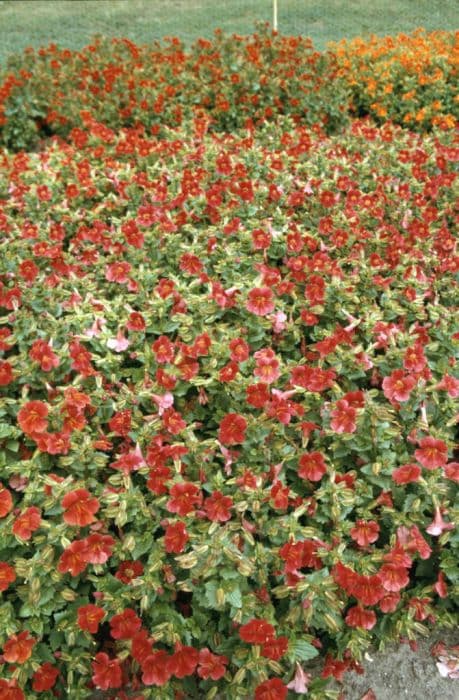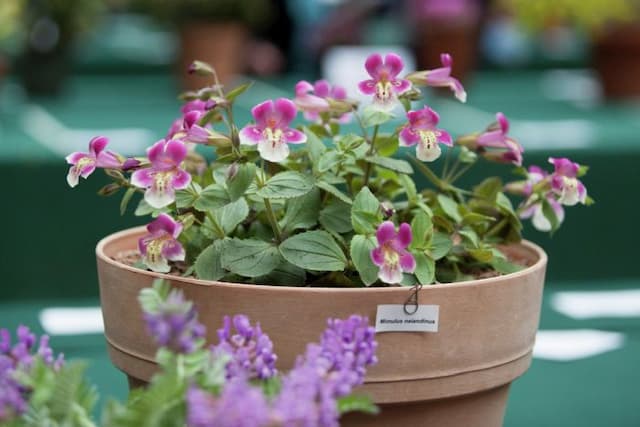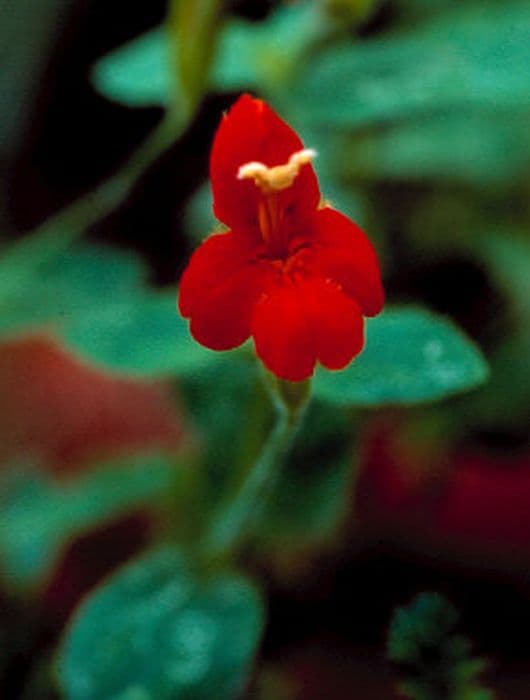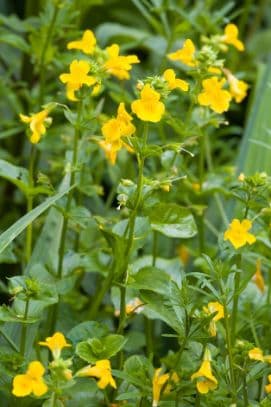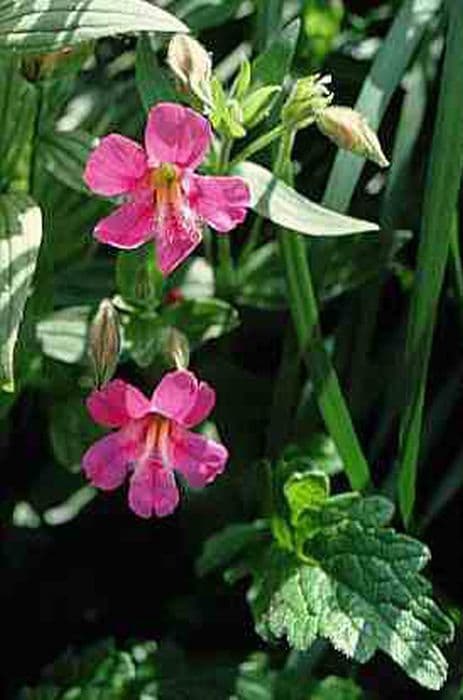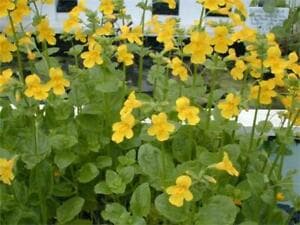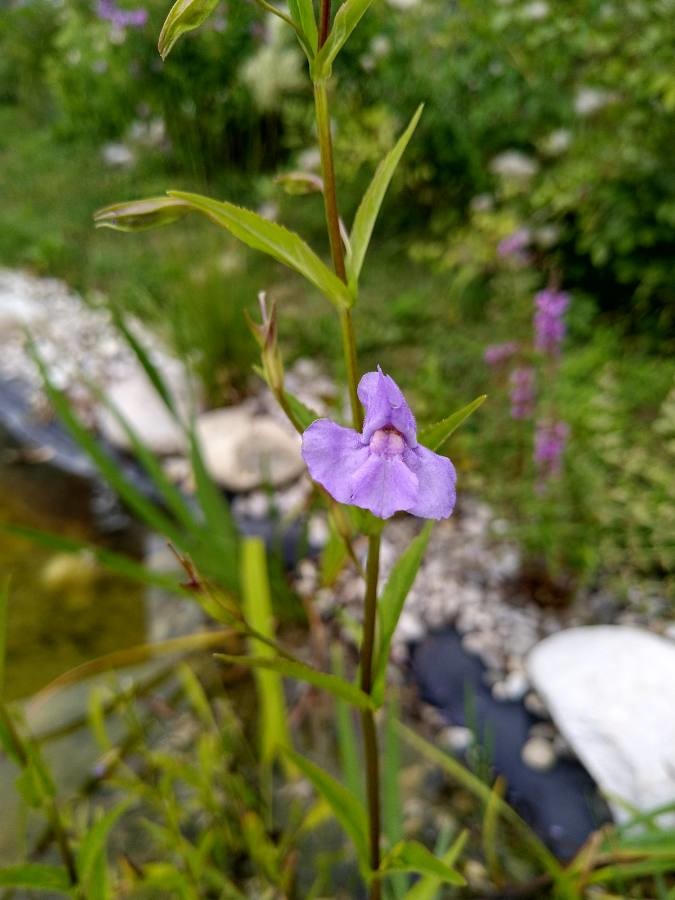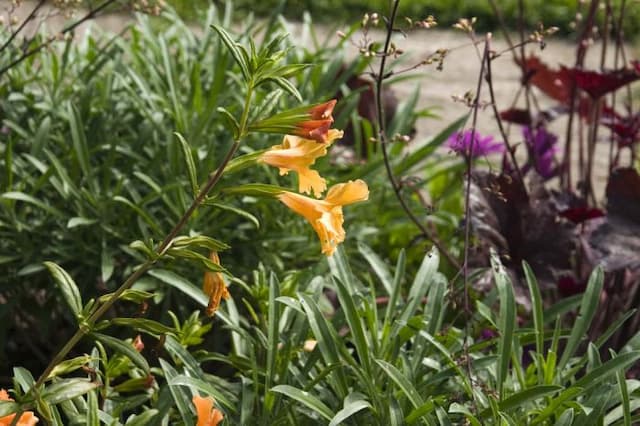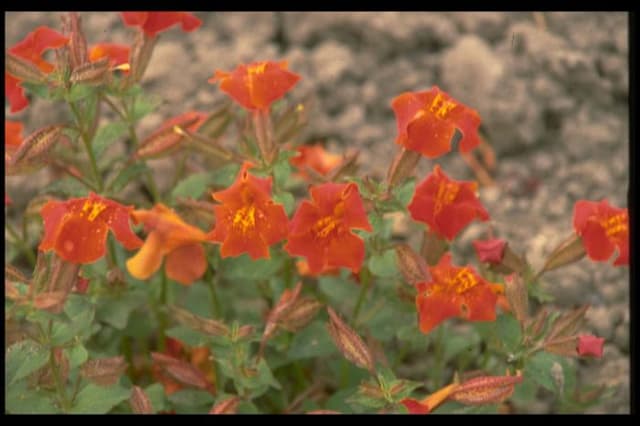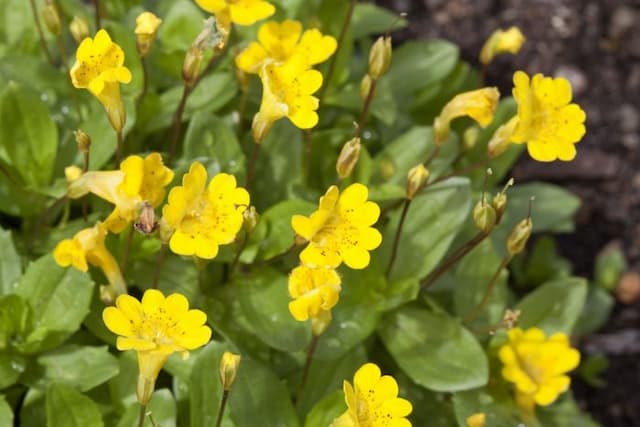Monkey Flower Mimulus 'Highland Red'
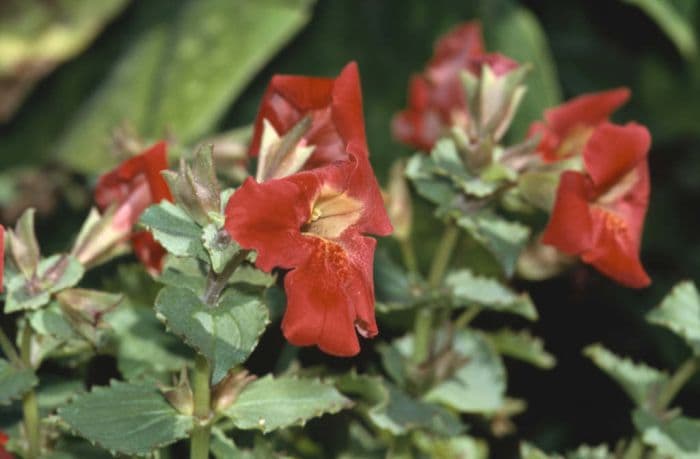
ABOUT
The Mimulus 'Highland Red', commonly known as the Monkey Flower due to its mimicking appearance of a monkey's face, boasts a vibrant display of rich, red flowers. These blossoms are tubular, flaring at the mouth into five distinct lobes, each looking like a little hood, which gives them a whimsical, almost monkey-like look. The interior of the blooms often features patterns of darker reds or burgundy, which can sometimes appear spotted, adding depth and contrast. These beautiful flowers are set against a backdrop of bright green foliage, which consists of leaves that are usually oval to lance-shaped, with a slightly serrated edge and a somewhat glossy surface. The Monkey Flower creates a lush and exotic mood in gardens and landscapes where it is used, its floral display being particularly striking and providing a splash of bold red color.
About this plant
 Names
NamesFamily
Phrymaceae
Synonyms
Monkey Flower, Sticky Monkey Flower, Highland Red Monkey Flower
Common names
Mimulus x hybridus, Mimulus 'Highland Red'
 Toxicity
ToxicityTo humans
The Mimulus 'Highland Red', commonly known as monkey flower, is not generally considered toxic to humans. There is limited information available about severe reactions from ingesting this plant. However, it is usually advised to avoid eating ornamental plants as they are not intended for consumption. If ingested in significant quantities, individuals might experience mild stomach upset, but serious toxicity is rare. Should symptoms develop after ingesting any part of this plant, it is recommended to consult a healthcare professional.
To pets
The monkey flower is also not known to be toxic to pets. However, to maintain caution, it is advisable to prevent pets from ingesting plants that are not part of their diet. While the monkey flower does not typically pose serious health risks, ingestion could potentially lead to mild gastrointestinal irritation, such as an upset stomach or vomiting in some pets. If any worrying symptoms arise after your pet has ingested monkey flower, please consult your veterinarian for advice.
 Characteristics
CharacteristicsLife cycle
Perennials
Foliage type
Deciduous
Color of leaves
Green
Flower color
Red
Height
1-2 feet (30-60 cm)
Spread
1 foot (30 cm)
Plant type
Herb
Hardiness zones
9
Native area
North America
Benefits
 General Benefits
General Benefits- Attracts Pollinators: Mimulus 'Highland Red' is known for attracting bees, butterflies, and other pollinating insects, which is beneficial for the garden ecosystem.
- Colorful Addition: The plant has vibrant red flowers, which add a splash of color to gardens and landscapes.
- Drought-Tolerant: Once established, it requires minimal watering, making it suitable for xeriscaping and low-water gardens.
- Easy to Grow: It is considered easy to care for, not requiring extensive gardening skills.
- Fast Growth: Mimulus 'Highland Red' grows relatively quickly, which is suitable for gardeners wanting to see results in a shorter period of time.
- Versatile Planting: It can be used in a variety of garden settings, including borders, containers, and as ground cover.
- Cold Hardy: The plant can withstand cooler temperatures, making it suitable for many climates.
- Deer Resistant: Its foliage is typically not favored by deer, reducing the risk of damage in areas with deer populations.
 Medical Properties
Medical PropertiesThis plant is not used for medical purposes.
 Air-purifying Qualities
Air-purifying QualitiesThis plant is not specifically known for air purifying qualities.
 Other Uses
Other Uses- Mimulus 'Highland Red', commonly known as Monkey Flower, can be used as a natural dye for fabrics, giving a light greenish-yellow hue when used in combination with other mordants and dyes.
- In educational settings, the plant serves as a great example for teaching botany and plant reproduction due to its interesting flower morphology and pollination mechanisms.
- Monkey Flower can be used in art projects; its unique flowers can be pressed and used in creating botanical prints or in resin jewelry.
- The plant's sticky leaves have been observed to occasionally trap small insects, making it a subject of interest for studies on incidental insect trapping by non-carnivorous plants.
- Certain cultures have used dried Monkey Flower blooms in potpourri mixes, contributing a subtle scent and a burst of color.
- The flower's nectar and petals are attractive to butterflies and hummingbirds and can be specifically cultivated to support local wildlife and pollinator gardens.
- Due to its preference for moist habitats, Monkey Flower is sometimes used in rain garden designs to aid in water management and soil erosion control.
- Photographers often seek out Monkey Flower for its vivid color and intricate patterns, making it a striking subject for botanical photography.
- With its delicate structure, the plant can serve as a bioindicator for water quality, particularly in riparian zones where it naturally thrives.
- Monkey Flower is sometimes used in landscape designs that focus on creating a naturalized or wild garden appearance.
Interesting Facts
 Feng Shui
Feng ShuiMimulus is not used in Feng Shui practice.
 Zodiac Sign Compitability
Zodiac Sign CompitabilityMimulus is not used in astrology practice.
 Plant Symbolism
Plant Symbolism- Courage: The common name for Mimulus 'Highland Red' is Monkey Flower, which often symbolizes courage and bravery. The bright red color of the 'Highland Red' variety also emphasizes strength and fearlessness.
- Protection: Monkey Flowers are associated with protection because they seem to embody a strong, lively presence that can ward off negativity.
- Playfulness: The Monkey Flower has a whimsical look, which can represent a sense of playfulness and joy in life's simple pleasures.
- Adaptability: Monkey Flowers can grow in a variety of conditions, symbolizing adaptability and the ability to thrive in changing environments.
 Water
WaterThe Monkey Flower, as Mimulus 'Highland Red' is commonly known, prefers consistently moist soil and should be watered regularly to maintain this moisture level. During the growing season, water the plant thoroughly whenever the top inch of soil feels dry to the touch, potentially around once a week depending on your climate and indoor conditions. Use lukewarm water and gently soak the soil until excess water drains out from the bottom of the pot—this might equate to around 16-32 ounces for a standard-sized pot. It's vital to ensure the plant is not left sitting in water, as this can lead to root rot. During winter months when growth slows, you can reduce watering frequency accordingly.
 Light
LightMonkey Flowers thrive in bright, indirect light but can tolerate some direct sunlight, especially in the cooler hours of the morning. The ideal spot for a Monkey Flower would be near an east or west-facing window where it will receive some direct sun but be protected from the harsh afternoon sunlight. Keeping the plant in consistent lighting conditions will promote healthy growth and vibrant blooming.
 Temperature
TemperatureMonkey Flowers prefer a moderate temperature range, ideally between 60-75 degrees Fahrenheit. They can survive temperatures down to 50 degrees Fahrenheit but are frost-sensitive and should not be exposed to temperatures below freezing. The optimal temperature range will encourage healthy growth and flowering, but extreme temperature fluctuations should be avoided to prevent stress to the plant.
 Pruning
PruningPruning a Monkey Flower is important to encourage bushier growth and more blooms. Prune back leggy stems and spent flowers regularly to promote a compact shape and continuous flowering. This plant responds well to pruning, so you can cut back up to one-third of the plant's height without causing damage. The best time for a major pruning is in the early spring, just as new growth begins.
 Cleaning
CleaningAs needed
 Soil
SoilThe Monkey Flower 'Highland Red' thrives best in a well-draining soil mix, rich in organic matter, with peat moss or compost as a base. A mixture of two parts peat to one part perlite or sand is ideal. This plant prefers slightly acidic to neutral soil with a pH range of 6.0 to 7.0.
 Repotting
RepottingMonkey Flower 'Highland Red' should be repotted annually to ensure optimal growth. Repotting is best done in spring before the onset of the growing season. Care should be taken not to damage the roots.
 Humidity & Misting
Humidity & MistingMonkey Flower 'Highland Red' prefers moderate to high humidity levels. Ideal humidity range is between 50-70%, as too low humidity can lead to leaf stress, while too high can foster fungal issues.
 Suitable locations
Suitable locationsIndoor
Place Monkey Flower 'Highland Red' in bright, indirect light.
Outdoor
Plant in partial shade with moist soil for Monkey Flower.
Hardiness zone
9-11 USDA
 Life cycle
Life cycleMimulus 'Highland Red', commonly known as Monkey Flower, begins its life cycle with germination after a period of seed dormancy, often requiring stratification to break dormancy and encourage sprouting. Following germination, the seedling establishes itself, developing a root system and foliage through the juvenile stage, with water and light being critical for its development. As it matures, the plant enters the vegetative stage, producing lush green leaves and branching stems in preparation for reproduction. The next stage is flowering, which for Mimulus 'Highland Red' involves the blooming of vibrant red flowers that attract pollinators, facilitating cross-pollination and sexual reproduction. After pollination, the plant sets seed, inside which embryonic plants develop, eventually leading to seed dispersal by various means such as water, wind, or animal movement. The final stage is senescence, where the plant's metabolic activities decline, leading either to its death after its annual life cycle or to a period of dormancy if it’s a perennial, waiting to regenerate in the next growing season.
 Propogation
PropogationPropogation time
Spring-Summer
Propogation: Mimulus 'Highland Red', also known as Monkey Flower, is a vibrant plant whose propagation is most effectively achieved using stem cuttings. The ideal time to undertake this procedure is late spring or early summer when the plant is actively growing. To propagate, select a healthy stem from the parent plant, ensuring it's about 4 to 6 inches long (10 to 15 cm) with several leaf nodes. Strip the bottom leaves off and dip the cutting end into a rooting hormone to encourage root development. Plant the stem cutting into a moist potting mix, with the leaf nodes buried where the roots will develop. Cover with a plastic bag to maintain high humidity and place in indirect sunlight. Roots typically form within a few weeks, after which the new plant can be gradually acclimatized to less humid conditions before eventual planting out.
